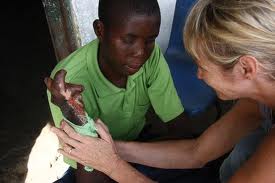Leprosy or Hansen’s disease is a chronic, infectious disease that mainly affects the skin, mucous membranes, and nerves. A rod shaped bacillus named Mycobacterium leprea, causes the virus. Mycobacterium leprea is very similar to the bacillus that causes tuberculosis. The reason Leprosy is also known as Hansen’s disease, is because it was first identified in 1874 by a Norwegian physician named Gerhard Henrik Armeur Hansen.
Leprosy appears in both the Old and New Testaments. In the bible Leprosy was not the disease that is recognized now, but as various  physical conditions that were nothing like the disease. A punishment from God was what these conditions were considered to be. The victim was said to be in a state of defilement. This Hebrew term was translated as lepros, which the word leprosy came from.
physical conditions that were nothing like the disease. A punishment from God was what these conditions were considered to be. The victim was said to be in a state of defilement. This Hebrew term was translated as lepros, which the word leprosy came from.
The disease’s probable origin was the Indus Valley that is located in India. Leprosy spread from there to the Mediterranean region and North Africa, then all of Europe was affected. This disease is much less common now, as the world case count has dropped below 1 million. During 1995 about 530 000 new cases of leprosy were discovered. It is obvious that third world countries have way more cases as India, Indonesia, and Myanmar account for almost 70% of the cases reported in the world. 5500 know cases of Leprosy still exist in the US, and about 200 cases a reported annually.
Tests to produce leprosy in experimental animals, have not been successful as of yet. Though the organism can be grown in Armadillos, several laboratories have been reported cultivating leprosy in the test tube.
Loss of sensation in a patch of skin is often the first symptom that Leprosy displays. In the lepromatous form, large areas of the skin may become infiltrated. The mucous membranes of the nose, mouth, and throat may be invaded by large numbers of the organism. Because of damage to the nerves, muscles may become paralyzed. The loss of sensation that accompanies the destruction of nerves may result in unnoticed injuries. These may result in secondary infections, the replacement of healthy tissue with scar tissue, and the destruction of bone. The classic disfigurements of Leprosy, such as loss of extremities from bone damage or the so-called leoline facies, a lionlike appearance with thick nodulous skin, are signs of advanced disease, now preventable with early treatment.
For many years the use of chaulmoogra oil was used for the treatment for Leprosy. Today drugs such as dapsone, rifampin, and clofazimine are used alongside a healthy diet. If killed too quickly, bacilli may cause a systematic reaction. The reaction is called erythema nodosum leprosum, or ENL may cause progressive impairment of the nerves. Corticosteroids control such reactions.
Of all contagious diseases Leprosy is maybe the least infectious. New patients are rarely ever quarantined. Most patients are treated on an outpatient basis. A Leprosy vaccine is currently under development.
